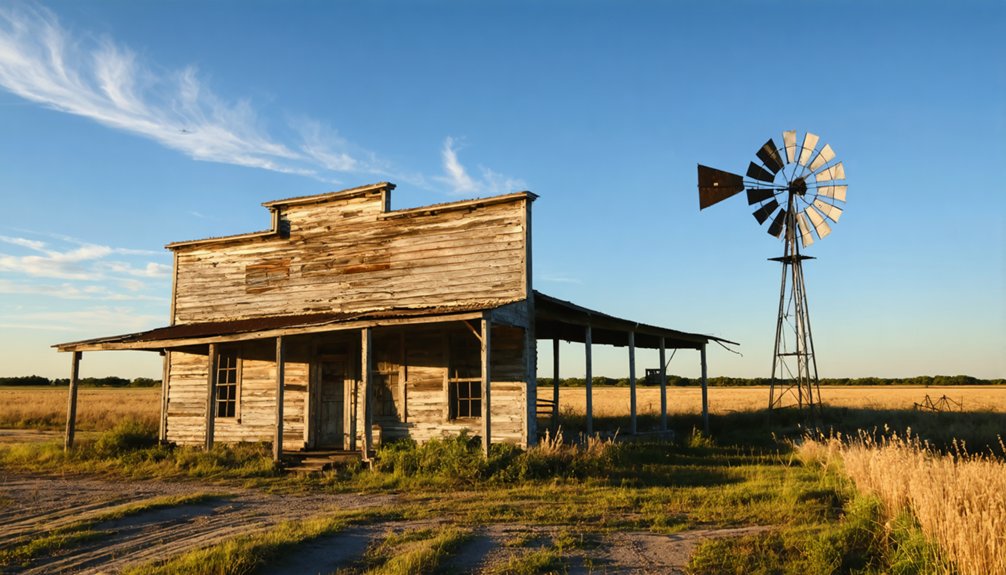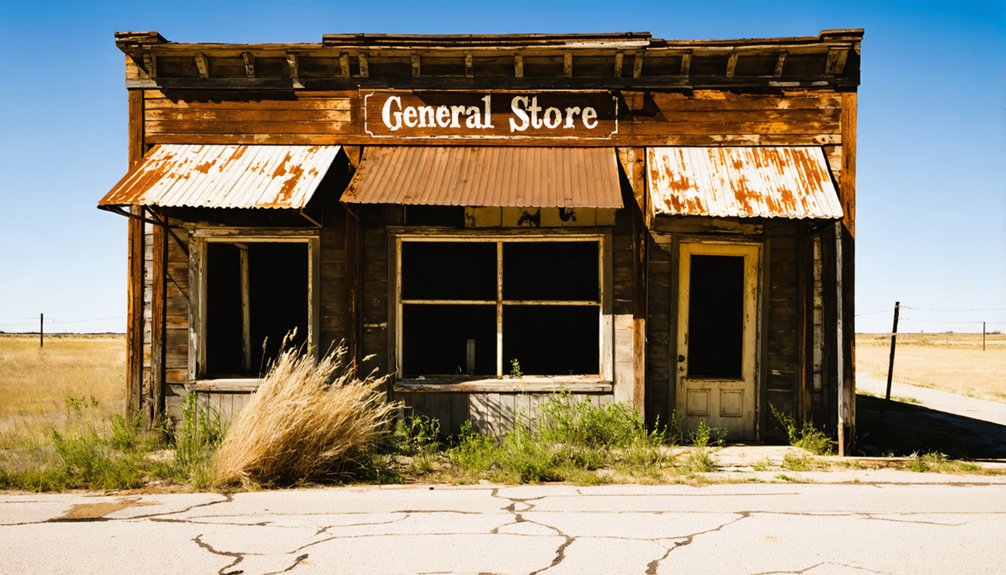You’ll find Osage’s ghost town remnants near modern-day Weimar, Texas, where it began as a thriving frontier settlement in the 1850s. The town served as a Confederate recruiting center during the Civil War and featured homes built with durable Bois d’arc wood blocks. By 1900, Osage’s isolation from essential rail connections led to its decline, with businesses relocating to nearby towns. Today, only scattered farmland marks where this once-bustling community stood, holding untold stories of Texas frontier life.
Key Takeaways
- Osage was established in 1856 by Dr. Samuel D. McLeary, with the Tom Hubbard family building the first homestead in 1851.
- The town served as a Confederate recruiting center during the Civil War and held strategic importance in Texas.
- Lack of railroad connections by 1900 led to economic decline as businesses relocated to nearby Weimar.
- A 1903 railroad shortcut to Wybark accelerated Osage’s decline by making it a transit point rather than destination.
- Today, only scattered farms and ranches remain where Osage once stood, with no preserved buildings or heritage sites.
Origins of the Bois D’arc Settlement
While the bois d’arc tree’s origins stretch back 30 million years to the Oligocene epoch, its influence on early Texas settlements proved particularly significant in the Blackland Prairies region.
You’ll find the bois d’arc significance deeply rooted in the area around modern-day Bonham, Texas, where Indigenous trade networks between the Osage and Caddo tribes helped spread the tree beyond its natural habitat.
The French fur trappers recognized the tree’s importance when they named Bois D’Arc Creek after observing Native American bow-making activities.
Early French trappers immortalized Native American archery culture by naming the waterway Bois D’Arc Creek after their bow-making craftsmanship.
This strategic location near Red River tributaries became a natural convergence point for settlers and Indigenous peoples alike. Banks in the region valued the tree’s durability so much that they required Bois d’Arc blocks for home loan approvals.
The tree’s versatility – providing durable wood for bows, natural fencing, and valuable dyes – made it an essential resource that shaped early settlement patterns and local economies. The wood was so prized that Native Americans would trade horses and women for bois d’arc bows.
Early Pioneers and Community Formation
As westward expansion surged across Texas in the mid-1800s, the rich, dark clay soil and abundant water resources along creek areas drew pioneering families to what would become Osage.
You’ll find that these early settlers, mainly Anglo-Americans from both Confederate and Union states, faced pioneer challenges while establishing farms near the Trinity River forks.
Community cooperation became essential as families built their homesteads, sharing resources and joining forces for farming and defense.
By 1856, when Dr. Samuel D. McLeary named the settlement, you’d have seen a growing network of farms taking advantage of the Trinity series soil.
The Tom Hubbard family became the first settlers in 1851, establishing their homestead in what would develop into a thriving community.
The proximity to trade routes and waterways strengthened the community’s position, while interactions with Native Americans involved both collaborative and contentious relationships over land and resources.
Similar to Oklahoma’s Osage County’s early days, the community saw cattle ranching begin as a primary economic activity for the growing settlement.
Daily Life in 19th Century Osage
Life in 19th century Osage centered around a vibrant mix of traditional Native American practices and emerging agricultural activities.
The Osage people skillfully balanced their ancestral traditions with new farming methods, creating a dynamic cultural landscape in the 1800s.
You’d find families engaging in both farming and buffalo hunting, showcasing the community’s adaptability to changing times. The town’s daily activities reflected a unique blend of cultural influences, from the Osage traditions of hospitality and communal living to the economic pressures of trade with French and Spanish merchants. Religious ceremonies honored their supreme life force WahKon-Tah, which guided many aspects of their spiritual lives.
In your daily interactions, you’d experience a structured society where family bonds and clan systems shaped social relationships. The community faced significant changes when they were forced to relocate to inhospitable land purchased from the Cherokee.
Children enjoyed considerable freedom while elders passed down tribal legends through storytelling sessions.
As white settlers increasingly moved into the region, you’d witness the gradual transformation of the community’s traditional ways, though many residents fought to preserve their cultural practices.
The Civil War Years
Three major developments marked Osage’s transformation during the Civil War.
First, you’ll find that the town emerged as a crucial Confederate recruiting center in 1861, supplying numerous soldiers to Company A of the 5th Texas Cavalry within Green’s Brigade. Like other Texas companies, they faced severe casualties during battles like Valverde where 23 men were wounded or killed.
Second, Osage’s strategic position strengthened the Confederate presence in both Texas and Indian Territory, where local recruits engaged in significant military actions under Stand Watie’s command.
Third, the formation of the Osage Battalion within the First Indian Brigade showcased the complex loyalties of Native Americans during the conflict. The battalion notably participated in the Second Battle of Cabin Creek, securing substantial military resources for Confederate forces.
The town’s Military Contributions rippled through the region, though at a heavy cost.
You’ll discover that these wartime developments strained local resources, altered demographics, and ultimately reshaped civil-military relations as Confederate forces struggled with discipline and civilian relations.
Agricultural Heritage and Local Economy
While Civil War activities shaped Osage’s military significance, the town’s enduring legacy rested on its agricultural foundation.
You’ll find the area’s rock-ribbed terrain and native bluestem prairie grasses were perfectly suited for cattle ranching, which became the cornerstone of local livelihoods. Some local families, like the Roach family, maintained 160-acre properties continuously since the 1930s. Family-owned ranches, often spanning hundreds of acres, dominated the landscape and passed through generations. Like many areas connected to the Native American heritage of the region, agricultural traditions were deeply rooted in the land.
Agricultural practices centered on livestock management, with traditional techniques like steer roping remaining integral to daily operations. The town once supported essential infrastructure including gins and smithies, while bois d’arc trees provided natural fencing materials.
Though Osage’s commercial center declined after a devastating 1936 fire, surrounding farmland persisted into the late 20th century. The Baptist church remained a focal point for the dispersed farming community until the area’s eventual shift to larger agricultural operations.
Railroad’s Impact on Town Survival
Despite regional railroad expansion transforming much of Texas in the late 19th century, Osage’s isolation from major rail lines ultimately sealed its fate as a ghost town.
You’ll find that while Texas boasted over 9,000 miles of track by 1900, Osage couldn’t secure the crucial rail connection that might’ve guaranteed its survival. Without rail access, the town struggled against the tide of urban migration that saw populations gravitating toward rail-connected communities.
Rail-served towns enjoyed slashed transportation costs, year-round reliable shipping, and access to distant markets. They attracted new residents, businesses, and secondary industries that bypassed isolated settlements like Osage.
As neighboring communities with railroad connections flourished into regional hubs, Osage remained dependent on slower, weather-dependent transport methods, gradually losing its economic viability and population.
From Bustling Town to Rural Farmland

You’ll find that Osage’s transformation from bustling settlement to ghost town accelerated after commercial establishments relocated to nearby Weimar by 1900.
What was once a vibrant community center dissolved into scattered farmhouses and ranch properties, with most traces of the original town vanishing by the early 1900s.
The land’s shift to agricultural use proved permanent, as former residential and commercial areas gave way to expansive farmland and ranching operations that continue to dominate the landscape today.
Railroad Seals Town’s Fate
After the Missouri-Kansas-Texas Railroad established an essential shortcut in 1903 connecting Osage to Wybark, the town’s destiny took an unexpected turn.
While you might’ve expected the railroad connections to boost Osage’s prosperity, they actually hastened its economic decline. The new rail configuration transformed Osage into a mere transit point rather than a thriving hub.
As rail traffic patterns shifted, you’d have witnessed local merchants and farmers desperately pooling resources to maintain their town’s relevance.
Yet the railroad companies’ routing decisions proved ruthless – they concentrated investment in other strategic junctions, drawing capital away from Osage.
The town’s isolation from major rail corridors sealed its fate, as commerce and passengers bypassed it for better-connected destinations, ultimately pushing Osage toward ghost town status.
Farmland Reclaims Past Glory
The fertile fields stretching across former Osage today tell a striking story of transformation.
You’ll find little evidence of the once-bustling Civil War-era settlement, as nature and agriculture have reclaimed what civilization left behind. The ghost town‘s deteriorating structures gradually gave way to crops and grazing land, while Harvey Creek continues to nourish the soil just as it did in the 1870s.
This agricultural shift wasn’t merely physical – it fundamentally altered the area’s economic identity.
Where schools and businesses once stood, you’ll now see scattered farms and ranches dominating the landscape. The remaining landowners have maximized their holdings for farming productivity, and the town’s commercial footprint has vanished beneath fields of crops.
It’s a powerful reminder of how quickly the land can reshape itself when human activity shifts course.
Historical Landmarks and Present-Day Remnants
Modern visitors searching for historic landmarks in Osage will find few tangible remnants of this once-thriving Texas community. Despite its historical significance as a Civil War-era settlement that contributed troops to Confederate regiments, time has erased most physical traces of Osage’s past.
You won’t find preserved buildings or maintained heritage sites in this remote corner of Colorado County. The town’s location near Harvey Creek, at the intersection of County Roads 205 and 208, offers little evidence of its 19th-century prominence.
While ghost town preservation efforts often maintain some structural remnants, Osage has succumbed completely to nature’s reclamation. The foundations of the 1870s schoolhouse and other buildings may lie hidden beneath decades of rural growth, leaving only scattered traces for determined explorers to discover.
Frequently Asked Questions
What Specific Diseases or Epidemics Affected Osage’s Population During Its Existence?
You won’t find documented disease outbreaks specific to Osage’s population. While common Texas ailments likely affected residents, historical records don’t attribute the town’s population decline to any particular epidemics.
Were There Any Notable Native American Conflicts in the Osage Area?
You’ll find records of tribal warfare between Comanche and other Native groups in this region, with territorial disputes leading to occasional skirmishes as tribes competed for hunting and settlement rights.
What Were the Average Land Prices in Osage During Its Peak?
You can’t pinpoint exact land values during Osage’s peak, but its absence of railroad access and limited economic growth suggests prices were lower than rail-connected Texas towns during the late 1800s.
Did Any Famous Outlaws or Lawmen Pass Through Osage?
While you might expect outlaw legends from a Texas frontier town, there’s no evidence of famous outlaws or lawman encounters in Osage. Its brief prominence focused on military service and education.
What Traditional Festivals or Celebrations Were Unique to the Osage Community?
You won’t find documented unique festivals in Osage’s cultural traditions, though community gatherings likely centered around their school events, religious meetings, and possible celebrations involving the namesake Osage Orange trees.
References
- https://en.wikipedia.org/wiki/Osage
- https://kids.kiddle.co/Osage
- https://www.youtube.com/watch?v=pRIJ7Iq6-6g
- https://www.youtube.com/watch?v=SyTlkr_4aFM
- https://www.texasescapes.com/CentralTexasTownsSouth/Osage-Texas.htm
- https://www.texasescapes.com/CentralTexasTownsNorth/Osage-Texas.htm
- https://www.tshaonline.org/handbook/entries/osage-tx-coryell-county
- https://www.ntxe-news.com/cgi-bin/artman/exec/view.cgi?archive=12&num=27107&printer=1
- https://www.npsot.org/posts/10-more-reasons-why-bois-darc-is-the-most-interesting-north-texas-native-species/
- https://www.beautifulhayscounty.org/hays-humm/bodark-tree



